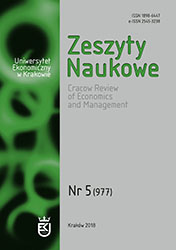Challenges in Cross-border E-commerce in the European Union
DOI:
https://doi.org/10.15678/ZNUEK.2018.0977.0510Słowa kluczowe:
handel elektroniczny, transgraniczny handel elektroniczny, bariery handlu elektronicznego, jednolity rynek cyfrowyAbstrakt
Tytuł artykułu: Wyzwania transgranicznego handlu elektronicznego w Unii Europejskiej
Handel elektroniczny (e-commerce), określany jako handel prowadzony za pośrednictwem sieci komputerowych, od wielu lat jest przedmiotem szczególnego zainteresowania. W artykule przedstawiono stan rozwoju elektronicznego handlu detalicznego w Unii Europejskiej, ze szczególnym uwzględnieniem internetowego handlu transgranicznego. Pomimo podejmowanych wysiłków handel elektroniczny w Unii Europejskiej nie ma charakteru jednolitego rynku. Konsumenci preferują zakupy online na rynkach krajowych. W artykule skupiono się na głównych wyzwaniach związanych z transgranicznym handlem elektronicznym B2C (business to consumer), tj. zakupach online indywidualnych konsumentów dokonywanych w innych krajach UE. Szczegółowo przeanalizowano wybrane istotne ograniczenia w tworzeniu w pełni zintegrowanego rynku handlu elektronicznego w Unii Europejskiej, związane z logistyką i dostawą, językiem i lokalizacją, przepisami prawnymi i podatkowymi oraz tzw. geoblokowaniem. Wskazano również działania podejmowane w celu zmniejszenia wpływu wymienionych ograniczeń.
Downloads
Bibliografia
Cardona M. (2016), Geo-blocking in Cross-border e-Commerce in the EU Digital Single Market, Institute for Prospective Technological Studies, Joint Research Centre. Digital Economy Working Paper, 2016/04, https://ec.europa.eu/jrc/sites/jrcsh/files/JRC101438.pdf (accessed: 6.03.2018).
Coad A., Duch-Brown N. (2017), Barriers to European Cross-border eCommerce, JRC Digital Economy Working Paper 2017-03, JRC105675, https://ec.europa.eu/jrc/sites/jrcsh/files/jrc105675.pdf (accessed: 6.03.2018).
Duch-Brown N., Cardona M. (2016), Delivery Costs and Cross-border e-Commerce in the EU Digital Single Market, Institute for Prospective Technological Studies, Joint Research Centre. Digital Economy Working Paper 2016/03. JRC101030, https://ec.europa.eu/jrc/sites/jrcsh/files/JRC101030.pdf (accessed: 6.03.2018).
Ecommerce Europe (2016a), Global E-commerce Report 2016, https://www.ecommerce-europe.eu/research/ecommerce-europe-reports (accessed: 1.03.2018).
Ecommerce Europe (2016b), European E-commerce Report 2016, https://www.ecommerce-europe.eu/research/ecommerce-europe-reports (accessed: 1.03.2018).
Ecommerce Europe (2016c), Cross-border E-commerce Barometer, https://www.ecommerce-europe.eu/publication/cross-border-e-commerce-barometer-2016/ (accessed: 1.03.2018).
Ecommerce Europe (2017), European Ecommerce Report 2017, https://www.ecommerce-europe.eu/research/ecommerce-europe-reports (accessed: 1.03.2018).
eMarketer (2016), Worldwide Retail Ecommerce Sales Will Reach $1.915 Trillion This Year, https://www.emarketer.com/Article/Worldwide-Retail-Ecommerce-Sales-Will-Reach-1915-Trillion-This-Year/1014369 (accessed: 3.03.2018).
eMarketer (2017), E-commerce Will Pass a Key Milestone This Year, https://retail.emarketer.com/article/ecommerce-will-pass-key-milestone-this-year/596e4c8cebd40005284d5ccd (accessed: 3.03.2018).
EUR (2016), The Value of Express Delivery Services for Cross-border E-commerce in European Union Markets, Erasmus University Rotterdam – Economic Institute Report EI2016-12, https://repub.eur.nl/pub/79921/EI2016-12.pdf (accessed: 6.03.2018).
Eurobarometer (2015), Consumer Attitudes towards Cross-border Trade and Consumer Protection, Flash Eurobarometer no. 397.
European Commission (2010), A Digital Agenda for Europe. Communication from the Commission, COM (2010) 245 final.
European Commission (2015), Why We Need a Digital Single Market, https://ec.europa.eu/commission/sites/beta-political/files/dsm-factsheet_en.pdf (accessed: 8.03.2018).
European Commission (2017), E-commerce Statistics for Individuals, http://ec.europa.eu/eurostat/statistics-explained/index.php/E-commerce_statistics_for_individuals (accessed: 6.03.2018).
European Parliament (2018), Regulation (EU) 2018/302 of the European Parliament and of the Council of 28 February 2018 on addressing unjustified geo-blocking and other forms of discrimination based on customers’ nationality, place of residence or place of establishment within the internal market, Official Journal of the EU, vol. 61.
Eurostat (2018), Complete Database. Science, Technology, Digital Society, http://ec.europa.eu/eurostat/data/database (accessed: 1.03.2018).
Garcia K. (2018), Cross-border Buyers Favor Global Platforms, eMarketer, https://retail.emarketer.com/article/cross-border-buyers-favor-global-platforms/5a78c8f9ebd4000744ae4104?ecid=NL1014 (accessed: 4.03.2018).
GfK (2015), Provision of Two Online Consumer Surveys as Support and Evidence Base to a Commission Study: Identifying the Main Cross-border Obstacles to the Digital Single Market and Where They Matter Most, Final report, https://publications.europa.eu/en/publication-detail/-/publication/1ee5f89c-812c-11e5-b8b7-01aa75ed71a1/language-en (accessed: 15.03.2018).
Giuffrida M., Mangiaracina R., Perego A., Tumino A. (2017), Cross-border B2C E-commerce to Greater China and the Role of Logistics: A Literature Review, International Journal of Physical Distribution & Logistics Management, vol. 47, no. 9.
Hell B. van, Lukic V., Leeuwis E. (2014), Cross-border E-commerce Makes the World Flatter, Boston Cons. Group, http://www.bcgperspectives.com/content/articles/ transportation_travel_tourism_retail_cross_border_ecommerce_makes_world_flatter/ (accessed: 6.03.2018).
International Post Corporation (2018), Cross-border E-commerce Shopper Survey 2017, https://www.ipc.be/en/knowledge-centre/e-commerce/cross-border-e-commerce-shopper-survey (accessed: 12.03.2018).
Martin, D. (2017), Key Business Drivers and Opportunities in Cross-border Ecommerce 2017: Expanding Internationally in an Increasingly Competitive Market, Payvision, https://www.payvision.com/key-business-drivers-2017 (accessed: 8.03.2018).
PayPal (2016), PayPal Cross-border Consumer Research 2016, https://www.ipsos.com/sites/default/files/migrations/en-uk/files/Assets/Docs/Polls/ipsos-paypal-cross-border-consumer-research-2016.pdf (accessed: 8.03.2018).
Paypers (2014), Cross-border E-commerce Report, Critical Facts and Insights for International Expansion – Poland, https://www.thepaypers.com/reports/cross-border-ecommerce-country-reports/r753142 (accessed: 8.03.2018).
Salesupply (2016), How to Boost Conversion for Cross-border Webshops, https://www.ingenico.com/binaries/content/assets/epayments/resources/white-paper-ingenico-epayments---how-to-boost-conversion-for-cross-border-webshops.pdf (accessed: 12.03.2018).
Valarezo A., Pérez-Amaral T., Garín-Muñoz T., García I.H., López R. (2017), Drivers and Barriers to Cross-border E-commerce: Evidence from Spanish Household Behavior, https://doi.org/10.2139/ssrn.3099541.
Xue Wanxin X., Dandan L., Yilei P. (2016), The Development and Current of Cross-border E-commerce, WHICEB 2016 Proceedings, no. 53.




